The First Resort
May 7, 2020



 Fishing,SCA Articles
Fishing,SCA Articles
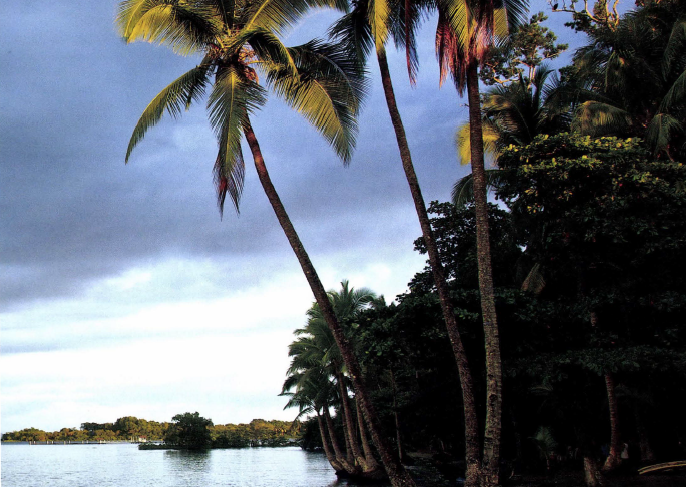
Your interest in angling doesn’t have to clash with your significant other’s interests. At Crocodile Bay Resort, you’ll find plenty of vacation for both of you.
I love to fish. My wife, however, doesn’t. Promises of gold, diamonds or Calphalon aren’t enough to persuade her to pick up a fishing rod, but she does love the outdoors.
Some time ago we set out to find a vacation destination that would allow me to fish and her to enjoy excursions that didn’t require casting a line. Finally, after many years, I found my holy grail at Crocodile Bay Resort, located on the Osa Peninsula of Costa Rica, just inside the Golfo Dulce in the town of Puerto Jimenez.
National Geographic has described the Osa Peninsula as “the most biologically intense place on earth.” You want biological intensity, this is the place.
For my likes, the diversity begins with fish in astronomical numbers. Offshore, beyond the mouth of the gulf on the rolling Pacific, you have tail-dancing billfish – marlin of the black, striped and blue varieties, as well as sailfish with their massive dorsals of electric royal purple. There are dorado, known also as mahi-mahi or dolphinfish – a hat trick all by itself. And then there are yellowfin tuna and wahoo, as well as any number of other surprises in the deep-blue tropical waters.
Inshore, the main character is the roosterfish, a heavyweight bruiser of a jack with a cockscomb dorsal that stands up like a waxed Mohawk and a fish on my bucket list. Roosters range from Baja to Panama, but the inshore waters of Osa Peninsula are considered by many anglers to be their epicenter.
Here, too, are a dozen species of snapper – the cubera being the star – as well as snook, barracuda, bonito, mackerel, sharks, trevally, African pompano… In short, biological intensity.
For my wife’s wants, Crocodile Bay offers opportunities to pan for gold, visit a sea-turtle rescue facility, kayak through the mangroves or on the ocean at sunset, climb and rappel waterfalls in the rainforest, ride horses, birdwatch, surf, snorkel and walk in the jungle at night. And those are the activities we didn’t participate in.
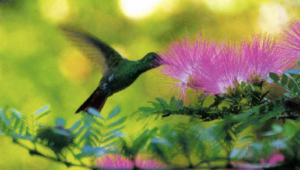
Our first morning there I woke at 5 a.m. to a chorus of raucous, chicken-like chachalacas and screeching scarlet macaws that fed in the almond trees outside my room. After eating a full breakfast, I headed to the pier, a pleasant walk down an orchid- and bottlebrush-lined path through a busy twittering of hummingbirds and cooing doves. I crossed a little bridge that spanned a shallow lagoon before reaching the blinding shore of Golfo Dulce. Palms and mangroves spread to the left and right, and straight ahead gleamed the pier that stretches 750 feet out into the azure gulf like a pathway to heaven. It’s so long, the resort’s fleet of Strikefishers and Boston Whalers at the far end are barely visible.
Down by the boats I found Todd Staley, who has been Crocodile Bay’s fishing director for the entirety of the resort’s 15-year existence, and he ushered me to a 27-foot Boston Whaler Outrage. I met him the previous evening during dinner, when he spoke with all the guests and checked on their fishing preferences for the day – inshore or offshore, number of anglers in the party, types of gear, food and drink inclinations, etc. Staley is one of the most experienced and knowledgeable fishing directors in all of Costa Rica, having managed the late Archie Fields’ famous Rio Colorado tarpon resort on Costa Rica’s Caribbean coast for several years prior to joining the staff of Crocodile Bay.
As I boarded the Whaler I met Jorge, who was the mate and a young man from Puerto Jimenez and one of about 130 locals who work at the resort. He aimed a hose at my feet and washed away the sand I left on the boat’s fantail. That caught my attention, and I looked around to notice not a lure or line out of place. In fact, that kind of care and attention to detail truly distinguished everything about our stay at Crocodile Bay.
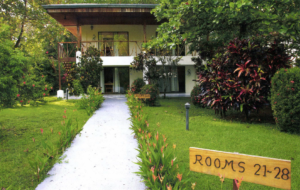 I also met Christian, the jovial, heavy-set captain who spoke and understood an indeterminate amount of English. I wanted to fly fish for roosterfish, but Christian suggested that we troll live bait through their preferred haunts. I expected as much. Staley told me that roosters are dumb on bait but extremely smart on flies.
I also met Christian, the jovial, heavy-set captain who spoke and understood an indeterminate amount of English. I wanted to fly fish for roosterfish, but Christian suggested that we troll live bait through their preferred haunts. I expected as much. Staley told me that roosters are dumb on bait but extremely smart on flies.
Out on the gulf, Christian and Jorge looked for collections of birds or nervous water to indicate schools of blue runners and sardines. There were none. They headed farther south, then into deeper water, then shallower, then farther west. Not a bird in sight. They look perplexed and conversed in Spanish before Christian broke into English and said, “This is unusual.”
Christian powered on but they soon spotted a small patch of nervous water. He and Jorge each grabbed a lightweight spinning outfit rigged only with a terminal sinker and a string of bare, golden hooks. They cast toward the school, and the fish spooked.
Christian motored off in a new direction. After an hour of searching they found what they were looking for, and the captain and mate began pulling in blue runners, sometimes two or three at a time, hooked loosely and flopping on the deck before Jorge tossed them into a live well and wiped up the mess.
They also found sardines, which are smaller than the blue runners and important in case the roosters are picky about size. With sufficient numbers of blue runners in one live well and sardines in another, we were off to catch roosters. The crew continued to shake their heads over the difficulty of catching bait, and I had a feeling that the biological intensity might be taking the day off.
Two blue runners and two sardines were dragged bait behind the boat from spinning outfits and baitcasting rigs. The baits were so feisty and fresh that Christian had to tighten the drags to keep the reels from whining. One of the spinning reels suddenly screamed like a banshee. Jorge plucked it out of the rod-holder and handed it to me.
“Do not strike!” yelled Christian. “We use circle hooks.”
I felt an instinctive need to set the hook, but the weight and pull on the rod confirmed a solid hook-up and made me wonder if the line had tangled around the propeller. Line screamed off the reel, and the entire rig felt as though someone was whacking it with a two-by-four – the fish’s head-shaking shook my whole body.
I bent, reeled and lifted and bent, reeled and lifted some more. Jorge asked if I needed the belt. I waved him off and tucked the rod butt under my arm (where later I found a bruise the size and color of an eggplant). After more fight, the leader appeared, and Christian and Jorge muscled the fish over the gunwale and straight into my weary arms.
The fish’s seven weird dorsal spines slapped benignly right across my idiot grin. Christian took a couple photos and slipped the roosterfish quickly and carefully back into the gulf. It weighed about 40 pounds, which is the high side of average.
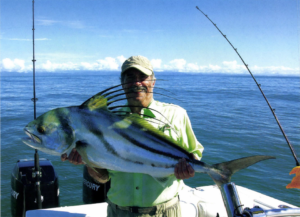
While still savoring my first rooster, another reel screamed. It was the baitcaster, so I used my other arm. This fish turned out to be about ten pounds lighter – it left a proportionately smaller bruise, too.
With two fish boated before 8:30, I thought, I was wrong. This is going to be one hell of a day, and once I’ve used up enough of that hard-won bait to be polite, I’m going to bust them on flies. But we didn’t see another fish all day.
That is not to say, however, that other guests had similar poor luck. Those who opted to go offshore had plenty of success with sailfish and mahi-mahi, one of which made its way onto the dinner menu, prepared to taste – broiled, baked, fried or, as I chose to engage it, blackened. A fellow named Russell from Wasilla, Alaska caught that particular fish and its length was just about equal to his height – one of the biggest dorado I’ve ever seen.
Meanwhile, back at the resort, while I was bagging my roosters and Russell was hauling in dinner, his wife Louise and my wife Susie were partaking in the kind of exceptional adventure that makes Crocodile Bay Resort such a magnificent destination for anyone – anglers, non-anglers, women, men and children. The resort offers a schedule of eco and adventure tours so extensive and varied that it outshines many resorts that specialize in such tours, yet do not focus on world-class fishing as well.
Susie and Louise opted to spend their morning visiting the Finca Kobo chocolate farm. There within the rainforest, the two of them were shown both the agricultural and production methods of a traditional cocoa plantation and Kobo’s new, experimental, organic methods of cocoa cultivation. Along with the visual treats of the rainforest – monkeys, toucans, parrots, 800 species of plants amid a riot of vines and foliage – they sampled the gustatory delights of the farm – fresh pineapple (yellow and white), star fruit, round and square bananas and chocolate for dipping.
Clearly these tours are not large-group events. Susie and Louise were the only visitors on the farm that day, and it’s common for most of the tours to include only three or four guests.
The tour of the chocolate farm is but one of 29 options, and all of the tours are led by one of two extraordinary naturalist guides: Dennis Atencio, who has been with the resort for seven years, and Diego Cedeno, who has been there for two years. They grew up in Puerto Jimenez and have a familiarity with the indigenous natural history and culture that is empirical as well as academic, as both of these young men have college degrees in the natural sciences. They share an uncanny ability to spot wildlife in deep shadow, within foliage at the top of a 100-foot tree, 50 yards away or while driving a Land Rover at 40 miles-per-hour.
Rather than fish on the second day, I chose to accompany Susie and two other guests on a rainforest and monkey tour with Dennis. In the trees, we saw howler and squirrel monkeys, toucans, a crested owl, trogons, parrots and hawks. And I saw my first three-toed sloth with her baby.
In the forest, Dennis showed us a couple interesting trees. The sap of one burned like kerosene and the sap of the other tasted like melted marshmallows. We also saw walking palms and gigantic trees, including fig, purpleheart, mahogany and ceiba.
That afternoon we ziplined 130 feet up in the rainforest canopy. We had a wild time flying through the treetops, suspended from a cable stretched from one tree platform to another. We descended from the top of the mountain to the bottom and then hiked back up, looking all the while for the tiny poison-dart frogs that hide amidst the dense rainforest flora.
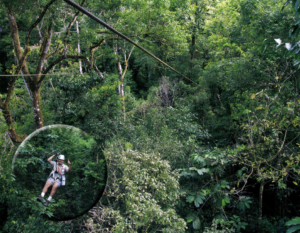
Of course, our hiatus from angling pretty much guaranteed that the reports of the day’s fishing would be spectacular.
“Get any roosterfish today?” I asked Christian.
“¡Sí, muchos!” he said.
The next day we planned to chase billfish, and the sign on the water seemed to point toward offshore success. Baitfish were active and everywhere, dotting the surface as we headed out of the gulf toward open ocean.
With squid daisy chains, bird teasers and outriggers along with six rods bouncing and gurgling the most seductive, fish-catching hardware known to man, we had high hopes.
From 6:30 a.m. until 2 p.m. we watched those lures and teasers swim in and alongside the turquoise wake of the twin Evinrudes and never saw a fish – not a bill, not a fin, not a flash. No dorado rushed from the cover of the dozen bits of flotsam we circled. No sword slashed at the flashy, gurgling lures. For seven-and-a-half hours I had no occasion to touch a fishing rod. But the ride was relaxing, the weather warm and sunny, the scenery stunning, and the salt air clean and salubrious. There are far worse ways to spend a day. Further, every experienced angler understands how the game often plays out.
We were not the only boat skunked. One other, beyond our sight, had the same kind of day, but several others had better luck. A group from Florida Sportswoman magazine caught a sailfish, a dorado and a bluefin trevally. Someone on another boat even caught a tarpon, which are known to migrate through the Panama Canal to spend a little time on the Pacific side of Central America before migrating back to the Caribbean.
In January, back home after my visit during the first week of December, I received Crocodile Bay Resort’s online newsletter, written monthly by Todd Staley, who had this to say:
There is just no way to sugar coat it. The first week or so in December the fishing was very slow. It wasn’t like it was fishless. There were some nice snappers to 46 pounds, roosters, a sail here and there, as well as a marlin, but the numbers were way down from a normal December.
Last week the numbers began to look a little better with more sails, some big dorado, blue and striped marlin, and the inshore was half decent. The tuna made a short visit and 3 over 100 pounds hit the rails.
I have impeccable timing.
Still, I think I have found the perfect place to vacation with Susie. The potential for catching a spectacular abundance and variety of inshore and offshore game fish is ever-present, and the non-angling diversions for Susie – and me too – are inexhaustible. Further, the service and hospitality are meticulous, the rooms are clean, spacious, air-conditioned, and the personnel are outstanding in their competence and dedication. What more is there to seek?
